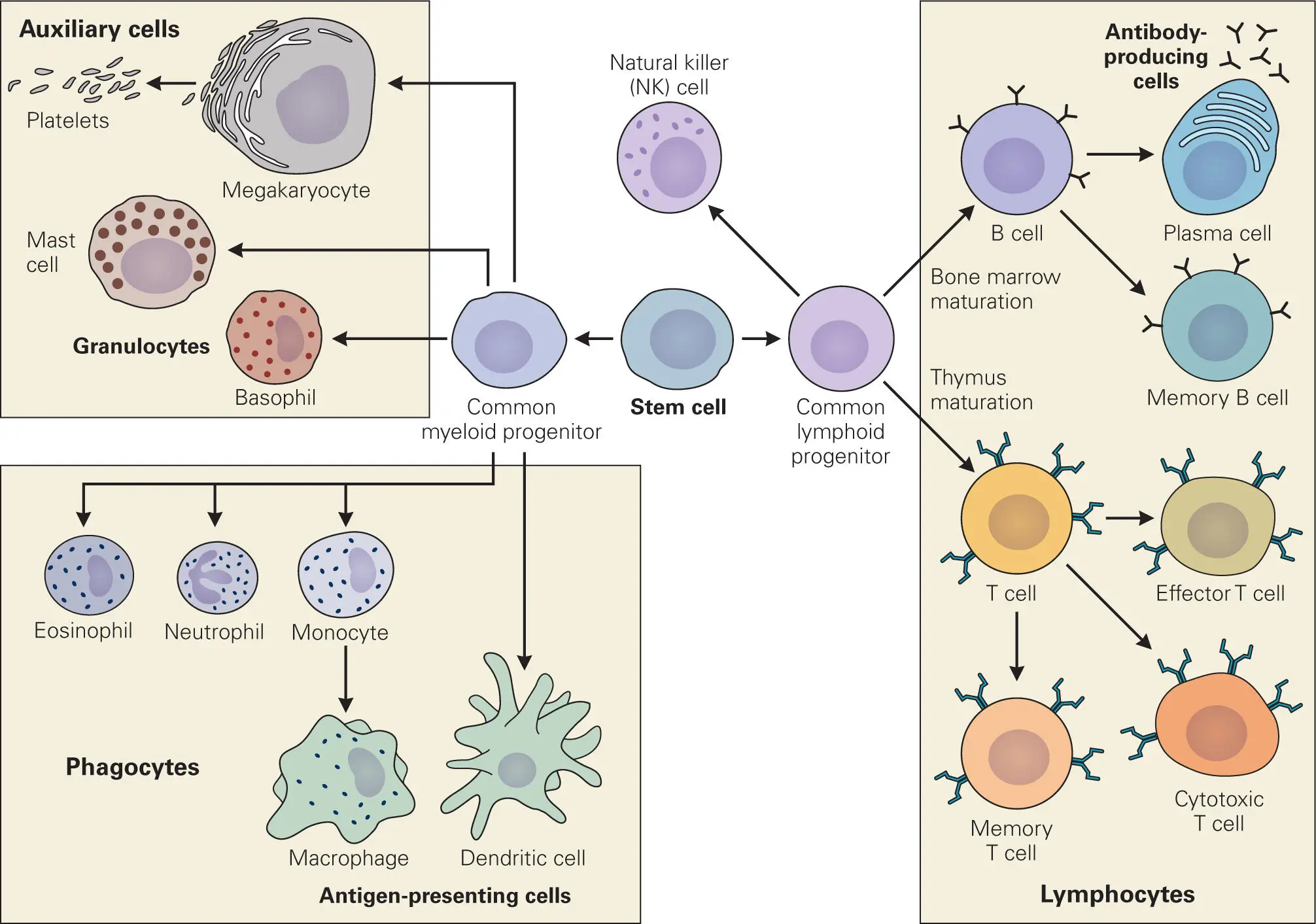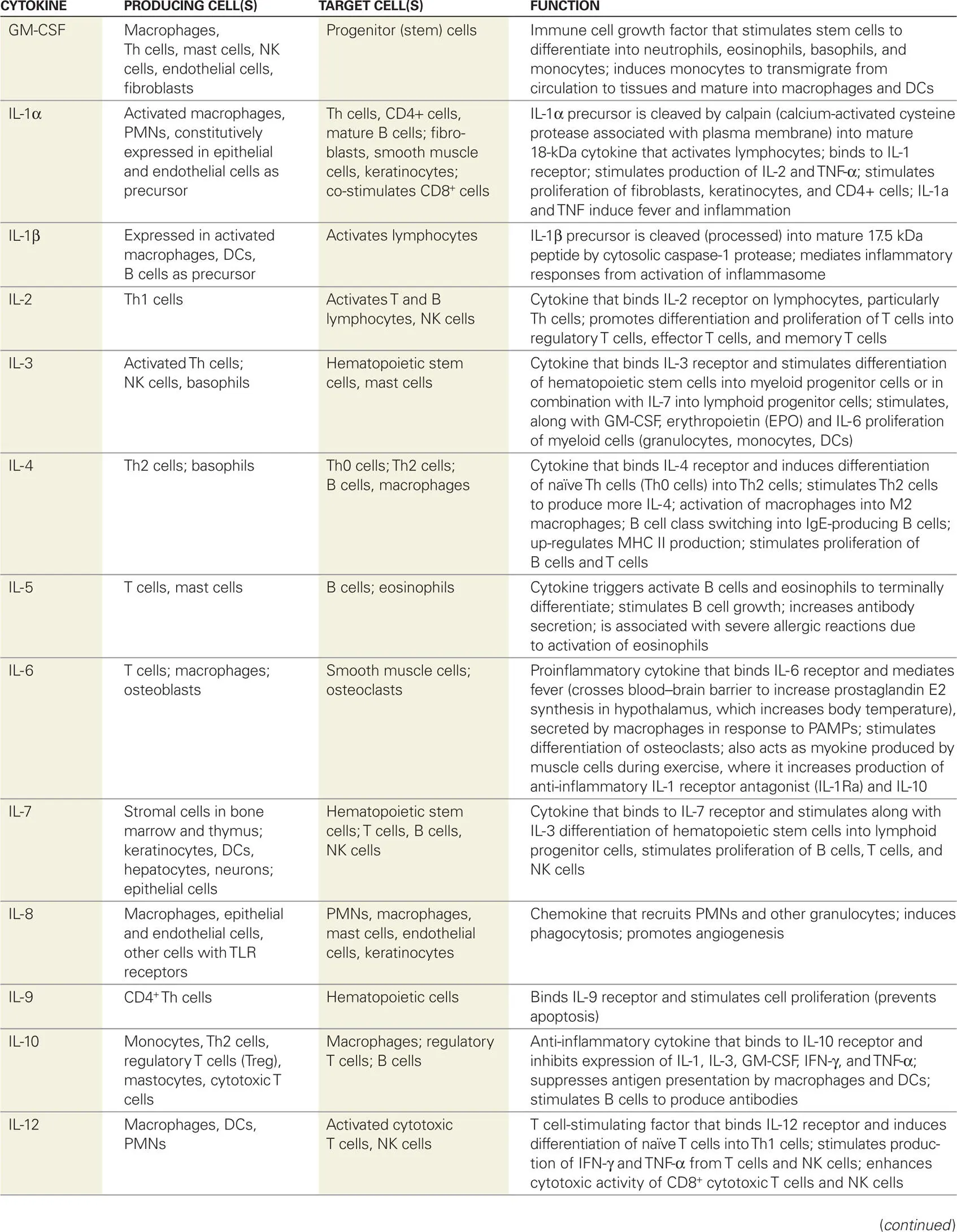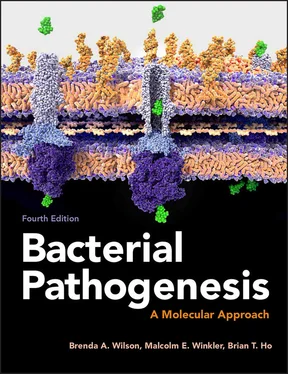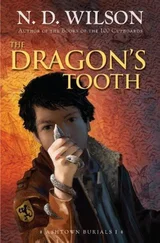
Figure 3-1. Characteristics and differentiation of the various types of leukocytes of the human body. Leukocytes can be divided into three groups: auxiliary cells (platelets, megakaryocytes, mast cells, and basophils); phagocytes (neutrophils, eosinophils, monocytes, macrophages, and dendritic cells); and two types of lymphocytes: B cells (antibody-producing B cells and plasma cells, memory B cells), and T cells (cytotoxic T cells [CTLs], effector T cells [helper Th1/Th2/Th17 cells, regulatory Treg cells], and memory T cells).
Neutrophils (PMNs)
Neutrophils (PMNs) are the most abundant phagocytic cell in the body. Found circulating in the bloodstream, they are the first phagocytes that arrive at a site of infection, usually within 30 minutes, and immediately engulf (phagocytose) invading microbes and release antibacterial components stored in their granules that destroy the bacteria, including: cationic peptides that poke holes in membranes; proteases, lipases, and hydrolases that degrade bacterial surface proteins, membranes, and toxins, respectively; lysozyme that hydrolyzes the peptidoglycan of bacterial cell walls; myeloperoxidase that generates toxic reactive oxygen species; and lactoferrin that sequesters iron away from the bacteria. Neutrophils secrete signaling molecules: chemokines that attract nearby monocytes and cytokines that stimulate their conversion into macrophages. They can also produce and, when stimulated, rapidly (within minutes) release neutrophil extracellular traps (NETs), networks of extracellular chromatin DNA fibers (chromosomal DNA with DNA-binding histones) that contain the proteases, elastase and cathepsin G, and myeloperoxidase. These NETs serve to trap and kill the bacteria extracellularly and prevent bacterial spread from the site of infection.
Monocytes, Macrophages, and Dendritic Cells (DCs)
Neutrophils, dendritic cells (DCs), and monocytes are derived from the same myeloid progenitor cells. In response to chemokines (chemical attractants) and other signals, monocytes and DCs leave the bloodstream and enter the site of infection. There, cytokines (stimulatory signaling molecules) released by damaged or infected cells trigger the monocytes to convert into macrophages, that are then activated by neutrophils at the site (see Table 3-2and later in this chapter).
Table 3-2. Selected immune cytokines/chemokines and their activities


Macrophages and DCs are included here as members of the innate immune system, but they will appear again in chapter 4as important members of the adaptive immune system. This is due to the fact that, upon first exposure to a particular pathogen, macrophages and DCs act to ingest and kill bacteria in a nonspecific way through the innate immune response, while also presenting pieces of the pathogens (antigens) to cells of the adaptive immune system. Upon subsequent exposure to a pathogen, monocytes and macrophages can also phagocytose invading bacteria that are coated with antibodies generated through the adaptive immune response. Macrophages engulf and digest cellular debris, microbes, foreign particles, infected or diseased host cells, and any other cell that does not possess the types of recognition surface molecules that indicate it is a healthy host cell.
Monocytes circulating in the blood have a half-life of about one day, but once they migrate from the circulating blood into tissues, they differentiate into different types of macrophages that become residents at the tissue sites, where they can survive for several months or years. Some examples of resident macrophages are the Kupffer cells of the liver, alveolar macrophages of the lung, and spleen macrophages. Macrophages can either stimulate the immune system and cause inflammation, or dampen the immune system and decrease inflammation through the release of specific signaling molecules (cytokines), depending on whether they are M1 macrophages or M2 macrophages, respectively. M1 macrophages metabolize the amino acid arginine into a reactive nitrogen species (nitric oxide) and stimulate inflammation, while M2 macrophages metabolize arginine into ornithine for cycling through the urea cycle to dampen the inflammatory response. M2 macrophages also release anti-inflammatory cytokines that promote repair of damaged tissue.
Dendritic cells are closely related to macrophages. Their name derives from the fact that they are covered with spiny projections that resemble the dendrites of neurons. They are instrumental in initiating and stimulating the second responder portion of the immune response, called adaptive immunity. DCs are found in tissues that are in contact with the external environment or the blood and, like macrophages, the resident forms of DCs found in the dermis or in various tissue sites develop from immature monocytes circulating in the blood. Dendritic cells, such as the specialized Langerhans cells of skin and mucosa, become activated when they recognize bacterial PAMPs and migrate through the lymphatic system to lymph nodes, where they mature and present antigens to, and stimulate the cells of, the adaptive defense system: T helper cells (Th cells), cytotoxic T cells (also called cytotoxic T lymphocytes or CTLs), and B cells. Chapter 4will provide a more detailed description of how DCs activate T cells and B cells.
Granulocytes: Basophils, Mast Cells, and Eosinophils
Basophils, mast cells, and eosinophils are immune cells that participate in the defense against infections, but they do not act as phagocytic cells. These granulocytes contain granules loaded with histamine, a vasodilator that promotes blood flow in tissues, and heparin, an anticoagulant that prevents blood from clotting too quickly. These cells are similar in appearance and function but differ in that basophils circulate in the blood, while mast cells congregate around blood vessels in connective tissue at mucosal sites. If any foreign material is detected, these cells release the contents of the granules, causing vasodilation. This helps the neutrophils and monocytes, which are normally circulating in blood, to leave the bloodstream and move to the site of infection. Eosinophils act similarly, but, unlike basophils and mast cells, they are primarily responsible for targeting multicellular parasites and viral invaders rather than bacteria.
Transmigration—How Do Phagocytes Know When and Where to Go?
Resident macrophages and DCs tend to localize in specific areas of the body. By contrast, neutrophils (PMNs) and monocytes, which are produced in the bone marrow, migrate constantly through the bloodstream. Neutrophils are the most abundant, but also the shortest-lived of the phagocytic cells; monocytes are longer-lived, but not as numerous. All of these phagocytic cell types, as well as NK cells, are capable of significantly damaging host tissues. It is not easy to kill bacteria, and considerable firepower (in the form of toxic substances released from granules or lysosomes) has to be brought to bear to destroy them. When this firepower is released by the PMNs, macrophages, and NK cells into the surrounding tissue, as is inevitable once the battle with invading bacteria is mounted, human cells also become vulnerable targets. The body protects itself from the potentially toxic action of these host defense cells by keeping them in the bloodstream in a quiescent, immature state unless danger is sensed.
Читать дальше















